I see you: bat masking tactics
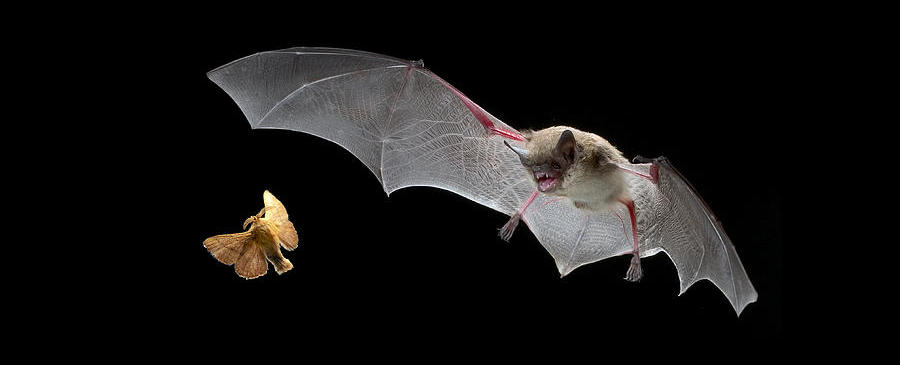
In the wildlife world, hunters and prey constantly play catch-up, both literally and figuratively. It is worth the hunter to develop new skills through evolution or other methods, as the prey adapts to them, so as not to be eaten. This is an endless poker game with a constant increase in bets, the winner who receives the most valuable prize - life. Recently, we have already examined the mechanism of protecting moths from bats , which is based on the generation of ultrasonic interference. Among insects, a delicacy for winged sonar, masking your ultrasound signal is a vital skill. However, bats do not want to stay hungry, because they have in their arsenal a skill that allows them to see prey despite the disguise. How exactly do bats cosplay Sauron, how effective are their hunting tactics and how do plant leaves help them in this? We learn about this from the report of the research group. Go.
Study basis
Bats have always evoked a wide range of feelings in people: from curiosity and reverence to outright fear and disgust. And this is understandable, because on the one hand these creatures are excellent hunters who use only hearing in the hunt, and, on the other, they are terrible night creatures that climb into their hair and strive to bite everyone (these, of course, are myths generated by human fears) . It is difficult to love the animal, which in popular culture is associated with Dracula and Chupacabra.
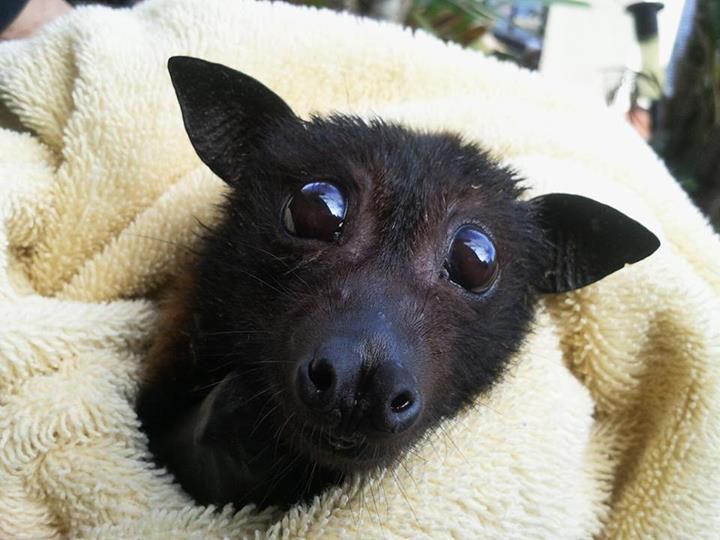
Hey, I'm completely fearless.
But scientists are impartial people, they don’t give a damn about how you look and what you eat. You are a fluffy rabbit or a bat, they will be happy to conduct a couple of experiments on you, and then also a dissection of your brain to complete the picture. Okay, we’ll leave black humor (with some truth) aside and move on to the point.
As we already know, the main instrument of bats during hunting is their hearing. Mice are active at night, due to fewer competitors / dangers and a greater number of prey. By emitting ultrasonic waves, bats pick up all the return signals that bounce off surrounding objects, including possible prey.
It is certainly cool to emit masking ultrasonic noise, but not all applicants for a bats supper position have such a talent. But even unthreading insects can hide their location. To do this, they need to merge with the environment, but not as a Predator from the film of the same name, because we are talking about sound. The night forest is full of sounds from a variety of sources, part of which is background noise. If the insect sits, say, on a leaf motionless, that is, there is a high probability that it will get lost in this background noise and survive until the morning.
Given this, many scientists believed that such prey for bats is simply unattainable, but this is not entirely true. Some species of bats were still able to solve the riddle of "invisible" insects and successfully catch them. The question remains - how? To answer this question, scientists from the Smithsonian Institution of Tropical Research used a biomimetic sensor that records any fluctuations in the echo from insects sitting quietly on leaves (i.e. hiding). Next, scientists calculated the ideal attack paths, that is, flight paths and capture angle for bats, which can help bypass camouflage. Then they checked their calculations and theories in practice, observing the bats attacking the disguised prey. It is curious that the leaves on which insects so carelessly sat served as a tool for their capture.
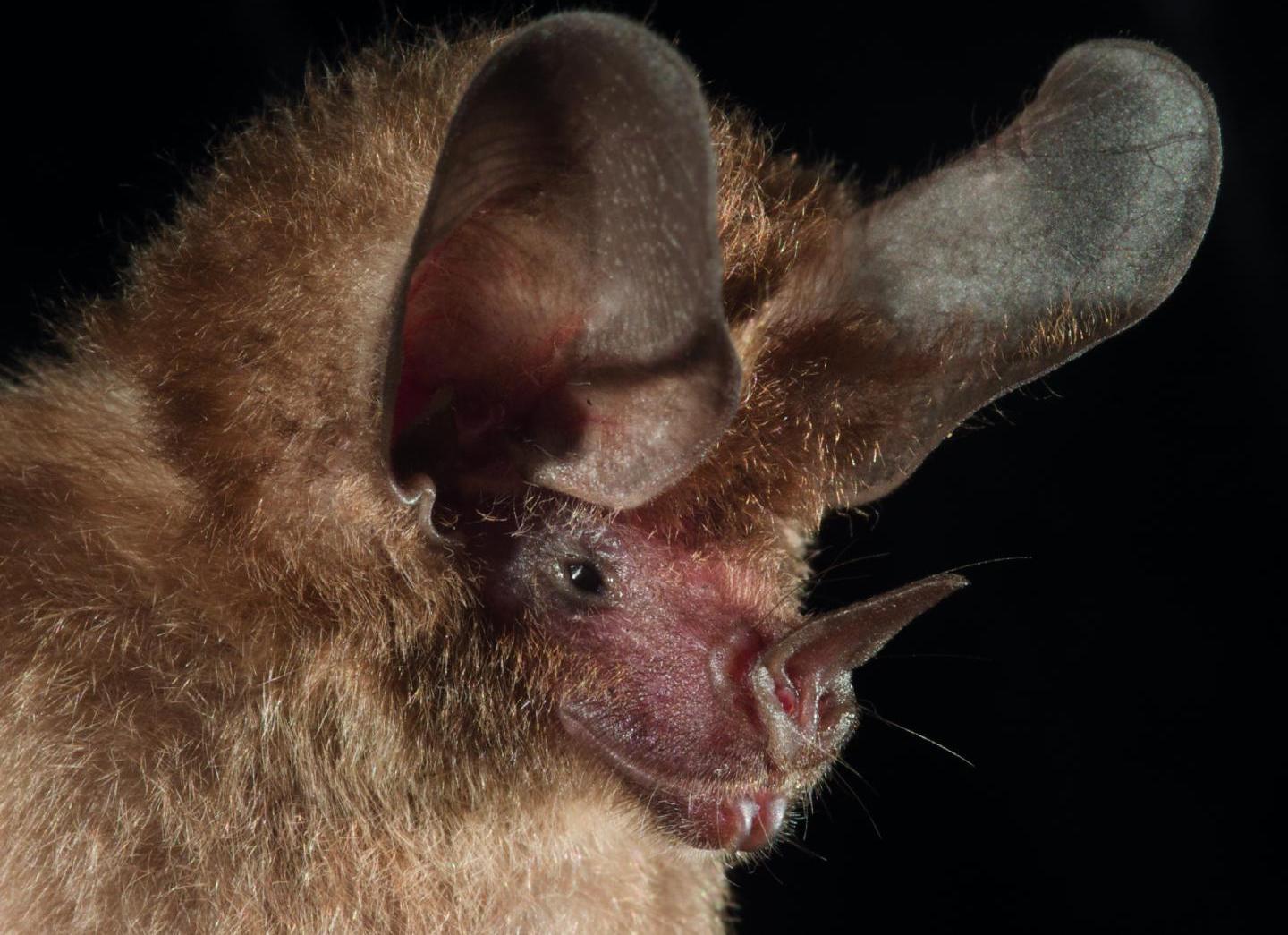
Isn't she a beauty?
The role of the subjects in this study was played by 4 males of the species Micronycteris microtis (ordinary large-eared bat), which were caught in their natural habitat on the island of Barro Colorado (Panama). During the experiments, a special cage (1.40 × 1.00 × 0.80 m) was used, located in the forest on the island. Scientists have recorded data on the flight of individuals placed in this cage. The next night after the capture, actual experiments began. 1 individual was placed in the cage, which was supposed to find and catch the “masked prey”. With one individual, no more than 16 hours of experiments were carried out (2 nights for 8 hours) in order to minimize the effect of spatial memory and stress for the animal. After the experiments, all the bats were released in the same place where they were caught.
Researchers had two main theories to explain how bats prey on disguised prey: acoustic shadow theory and acoustic mirror theory.
The “acoustic shadow” effect occurs when an object on the surface of the sheet dissipates the energy of the echo, thereby reducing the strength of the echo from the surface of the sheet. To maximize the acoustic shadow of the object, the bat should approach directly in front in the direction perpendicular to the background surface ( 1A ).

Image No. 1
In the case of an acoustic mirror, forest bats act like their trawl relatives, which capture prey from the surface of a reservoir. Echolocation signals emitted at a low angle to the surface of the water are reflected from a hunting bat. But the echo from the possible prey is reflected back to the bat ( 1B ).
The researchers suggested that the leaves act like a surface of water, i.e. act as a signal reflector ( 1C ). But for the full mirror effect, a certain angle of attack is needed.
In accordance with the theory of acoustic shadow, bats should attack prey from the frontal direction, so to speak, in the forehead, because in this case the shadowing will be the strongest. If an acoustic mirror is used, then the attack must take place at a maximum angle. In order to establish which particular angle of attack can be optimal, scientists conducted acoustic measurements at different angles relative to the sheet.
After completing the calculations and testing theories, behavioral tests were carried out with the participation of live bats and a comparison of the results of observations with the results of theoretical modeling.
Results of calculations and observations
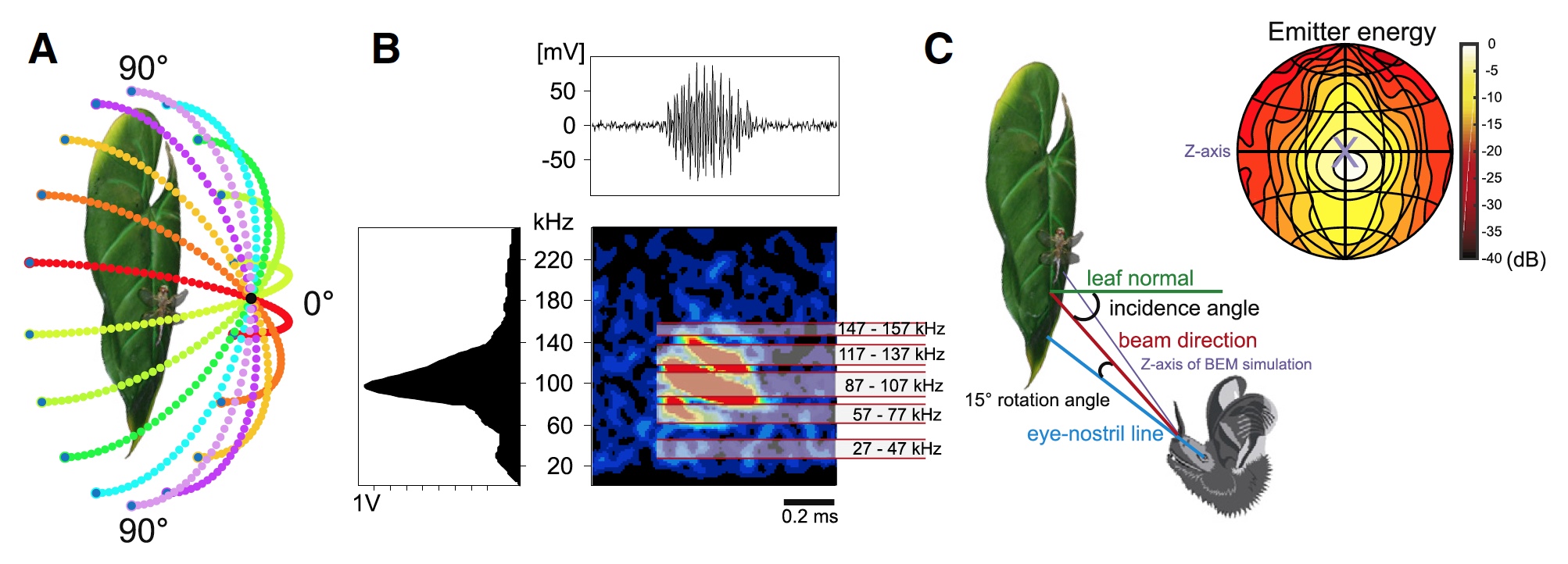
Image No. 2
First of all, an acoustic model (dome) was created for the sheet with and without extraction, by combining all the echo signals at different angles of attack into one picture. As a result, 541 positions were obtained on 9 semicircular paths around the sheet ( 2A ).
For each point, the spectral power density * and the acoustic size * (TS - target strength) of the target (i.e., echo intensity) were calculated for 5 different frequency ranges, which approximately correspond to the harmonic components of the outgoing bat signal ( 2B ).
Power spectral density * - distribution function of signal power depending on frequency.
Acoustic size * (or target acoustic power) is a measure of the area of an object in terms of the response of the acoustic signal.Figure 2C shows the results of the derived angles of attack, which are the angles between the normal relative to the surface of the sheet at the center of production and the position of the signal source, i.e. the bat.
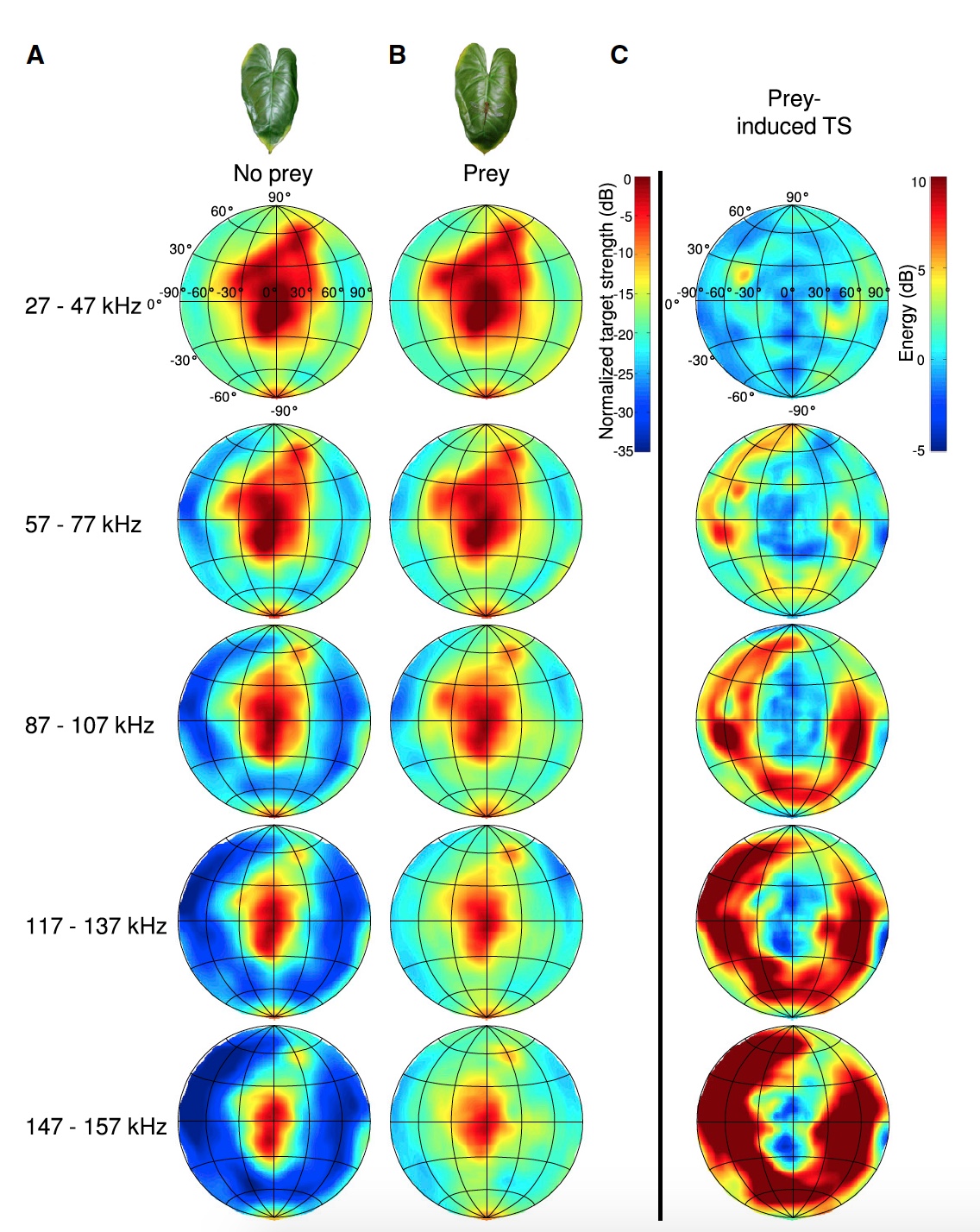
Image No. 3
Observations showed that both types of sheets (with and without extraction) in all frequency ranges show the largest acoustic size at angles <30 ° (central parts of graphs 3A and 3B ) and smaller acoustic size at angles ≥ 30 ° (outer part of graphs at 3A and 3B ).
Image 3A confirms that the sheet really acts as an acoustic mirror, that is, at angles <30 ° a strong mirror echo is generated, and at ≥ 30 ° the echo is reflected from the sound source.
Comparison of the sheet with production on it ( 3A ) and without production ( 3B ) showed that the presence of production increases the acoustic size of the target at angles ≥ 30 °. In this case, the echo-acoustic effect of production on the sheet is best seen when constructing TS induced by production, i.e. differences in TS between the sheet with and without production ( 3C ).
It is also worth noting that an increase in the acoustic size of the target at angles ≥ 30 ° is observed only in the case of high frequencies, at low frequencies there is no additional effect at all.
The above calculations made it possible to theoretically determine the range of angles of attack in the case of the theory of specular reflection - 42 ° ... 78 °. In this range, the same increase in the acoustic target size was observed from 6 to 10 dB at higher frequencies (> 87 kHz), which is consistent with the acoustic data of M. microtis bats.
A similar method of hunting (at an angle, so to speak) makes it possible for a predator to quickly determine the presence / absence of prey on a leaf: weak and low-frequency echo - the leaf is empty, strong and broadband echo - there is a yummy on the leaf.
If we consider the theory of acoustic shadow, then the angle of attack should be less than 30. In this case, according to the calculations, the interference between the echoes of the sheet and production is maximum, which leads to a decrease in TS compared to the echo of the sheet without production, i.e. this leads to an acoustic shadow.
With the calculations done, let's move on to the observations.
During observations, various insects from the diet of bats located on an artificial leaf were used as prey. Using two high-speed cameras and an ultrasonic microphone, bats were recorded as they approached the prey. From the records, 33 flight paths of bats approaching and landing on prey were recreated.
A bat attacks prey.
Flight paths were based on the position of the nostrils of bats during each frame during their transmission of their signal.
As expected, observations showed that bats were approaching prey at an angle.
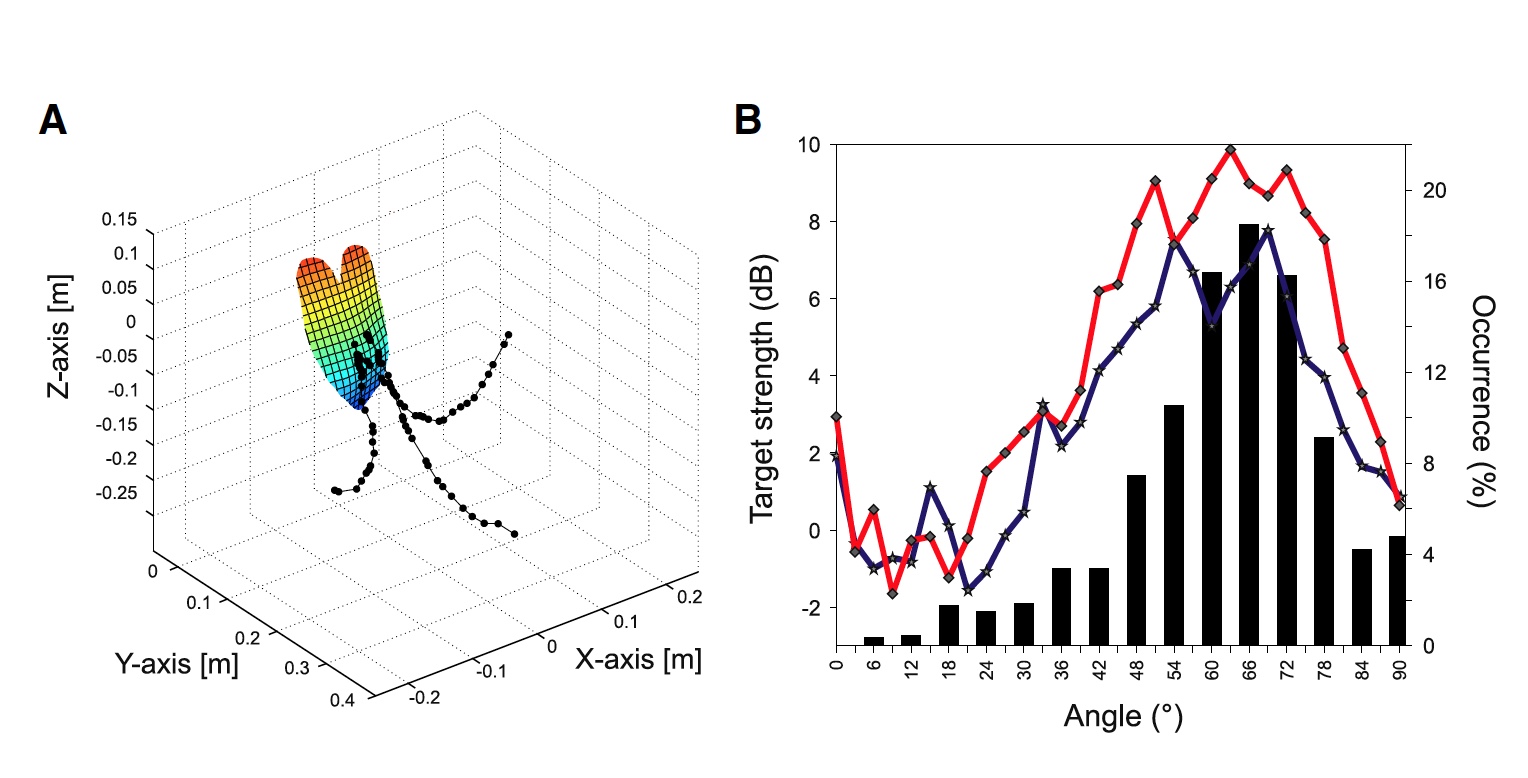
Image No. 4
Image 4A shows a three-dimensional map of the trajectories of an attack on a prey. It was also found that the distribution of angles of attack corresponds to acoustic-size curves for higher frequencies ( 4V ).
All experimental subjects attacked the target at angles <30 ° and clearly avoided more frontal directions. Of all the attack angles observed during the experiments, 79.9% were in the predicted optimal range of 42 ° ... 78 °. More precisely, 44.5% of all angles were in the range of 60 ° ... 72 °.
Angle mining attack and spectrograms of the emitted acoustic signal.
Another observation is the fact that bats have never attacked prey from above, as other researchers suggested.
For a more detailed acquaintance with the nuances of the study, I recommend that you look into the report of scientists and additional materials to it.
Epilogue
The use of echolocation as the main, and sometimes the only, hunting tool is already a very unique and amazing phenomenon. However, bats do not cease to amaze, demonstrating much more complex attack tactics than previously thought. Finding and catching prey that doesn’t hide is not difficult, but finding and catching an insect that is trying to hide in the acoustic background noise requires a different approach. In bats, this approach is called acoustic shadow and acoustic mirror. When flying up to a leaf at a certain angle, the bat instantly determines the presence or absence of probable prey. And if there is one, then dinner is guaranteed.
This study, according to its authors, may lead the scientific community to new discoveries in acoustics and echolocation both in general and among the animal world. In any case, to learn something new about the world that surrounds you, and about the creatures that live in it, has never been a bad thing.
Friday off-top:
To survive, sometimes it’s not enough to be a great hunter. When there is incredible cold around, and there is no food at all, the only thing left is to sleep.
To survive, sometimes it’s not enough to be a great hunter. When there is incredible cold around, and there is no food at all, the only thing left is to sleep.
Off Top 2.0:
Someone uses speed, someone uses force, and someone just needs to be quiet, like a shadow.
Thank you for your attention, stay curious and have a great weekend everyone, guys! :)
Someone uses speed, someone uses force, and someone just needs to be quiet, like a shadow.
Thank you for your attention, stay curious and have a great weekend everyone, guys! :)
Thank you for staying with us. Do you like our articles? Want to see more interesting materials? Support us by placing an order or recommending it to your friends, a 30% discount for Habr users on a unique analogue of entry-level servers that we invented for you: The whole truth about VPS (KVM) E5-2650 v4 (6 Cores) 10GB DDR4 240GB SSD 1Gbps from $ 20 or how to divide the server? (options are available with RAID1 and RAID10, up to 24 cores and up to 40GB DDR4).
Dell R730xd 2 times cheaper? Only we have 2 x Intel TetraDeca-Core Xeon 2x E5-2697v3 2.6GHz 14C 64GB DDR4 4x960GB SSD 1Gbps 100 TV from $ 199 in the Netherlands! Dell R420 - 2x E5-2430 2.2Ghz 6C 128GB DDR3 2x960GB SSD 1Gbps 100TB - from $ 99! Read about How to Build Infrastructure Bldg. class c using Dell R730xd E5-2650 v4 servers costing 9,000 euros for a penny?
All Articles